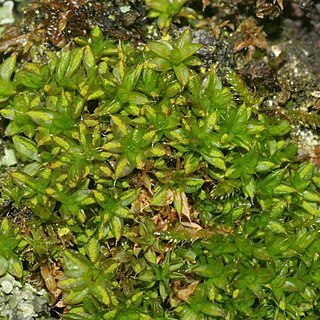Stems 1-4(-8) mm. Leaves incurved and slightly twisted when dry, erect to wide-spreading when moist, spatulate, (1.5-)2-3 × 0.75-1.25 mm; margins incurved when dry, plane to erect when moist, entire or occasionally serrulate near the apex; apices acute; costa excurrent into a short, smooth or serrulate, yellowish or hyaline awn 1/8-1/5 the leaf length, yellow or red, rounded and sharply papillose-serrate abaxially, smooth on the adaxial surface; basal cells gradually differentiated; distal cells isodiametric, rounded-hexagonal, 14-22 µm, papillae abaxial, single, simple, rarely forked near the costa, cells rather thick-walled, collenchymatous; cells elongate near leaf apex. Specialized asexual reproduction by gemmae borne on the adaxial surface of the costa, spherical or ovoid, 4-10-celled, brown when mature, smooth. Sexual condition reportedly dioicous. Sporophytes not known from the flora region.
Plants small. Stems 2-8 mm long, with central strand. Leaves broadly spathulate, 2.0-2.5 mm long; apex obtusely acute to rounded; margins plane; costa excurrent as short, yellowish, weakly toothed awn, spinose dorsally. Upper laminal cells hexagonal to polygonal, 1(2) spinose papillae dorsally; basal cells rectangular. Gemmae on dorsal surface of costa, round, multicellular. Sporophytes not known in area.

